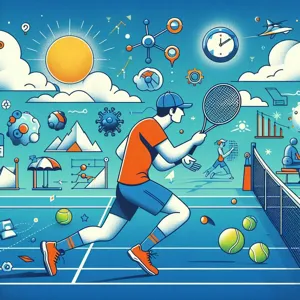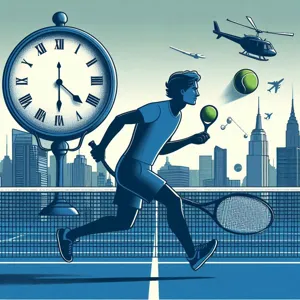In the dynamic world of tennis, the ability to adapt can be the difference between triumph and defeat.
Whether you’re facing an opponent with a powerful serve, dealing with unpredictable weather conditions, or navigating the pressures of a high-stakes match, mastering adaptability is essential for any player looking to elevate their game. This blog post delves into the art of flexibility on the court, offering practical strategies and expert insights to help you adjust your technique, mindset, and tactics in real-time. From honing your footwork to enhancing your mental resilience, we will explore how embracing adaptability not only improves your performance but also transforms your overall approach to the sport. Join us as we uncover the secrets to becoming a versatile player who can thrive in any situation and take your tennis game to new heights.
1. Understanding Adaptability in Tennis

Adaptability in tennis is the cornerstone of a successful game, allowing players to thrive in a fast-paced and ever-changing environment. At its core, adaptability means being able to adjust your tactics, techniques, and mental strategies in response to various factors during a match. Whether it’s changing weather conditions, unexpected opponent styles, or fluctuating court surfaces, the ability to pivot effectively can make all the difference between victory and defeat.
In tennis, every match presents a unique set of challenges. A player may start strong, but as the game progresses, they might find themselves facing an opponent who plays a completely different style than anticipated. For instance, a powerful server may suddenly face a counter-puncher who excels at reading the ball and returning shots with precision. In these moments, the ability to adapt becomes crucial. It’s about recognizing the cues in your opponent’s gameplay and being willing to alter your strategies accordingly—perhaps by incorporating more drop shots against a player who prefers to stay behind the baseline, or adopting a more aggressive net approach to pressure a hesitant opponent.
Moreover, mental adaptability is just as significant as physical adjustments. The best players learn to manage their emotions and focus, even when the game takes unexpected turns. This means maintaining composure after a missed opportunity or a bad call, and recalibrating one’s mindset to refocus on the next point. Additionally, understanding how to cope with environmental factors, such as playing in extreme heat or windy conditions, further emphasizes the importance of being adaptable.
To truly master adaptability in tennis, players should cultivate a mindset that embraces flexibility and resilience. Engaging in diverse practice scenarios, studying various playing styles, and regularly reflecting on match experiences can enhance one’s ability to adapt fluidly in real-time during matches. In the unpredictable world of tennis, those who can adjust, learn, and evolve will undoubtedly elevate their game, turning challenges into opportunities for growth and success.
2. The Importance of Mental Flexibility on the Court
In the fast-paced world of tennis, physical prowess is only part of the equation; mental flexibility plays an equally crucial role in determining your success on the court. The ability to adapt your strategy, adjust your mindset, and respond to the ever-changing dynamics of a match can be the difference between victory and defeat. Mental flexibility allows players to navigate unexpected challenges—be it a sudden shift in weather, an opponent’s unorthodox playing style, or even the pressure of a high-stakes tournament.
Imagine stepping onto the court, ready to execute your meticulously planned game strategy, only to find your opponent employing tactics that throw you off your rhythm. In these moments, mental flexibility becomes your greatest ally. It empowers you to quickly shift gears, rethink your approach, and find creative solutions to counter your opponent’s game. Whether it’s adjusting your serve placement or altering your footwork patterns, being mentally agile allows you to maintain your composure and confidence as you navigate the ebb and flow of the match.
Moreover, cultivating mental flexibility fosters resilience. Tennis is often a game of highs and lows, where one moment you’re riding the wave of momentum, and the next, you’re facing adversity. Players who embrace mental adaptability can better handle setbacks—whether it’s a string of unforced errors or a sudden drop in energy levels. Instead of succumbing to frustration or despair, they can recalibrate their focus, regroup, and approach the next point with renewed vigor.
To enhance your mental flexibility, practice mindfulness and visualization techniques off the court. By training your mind to remain open and responsive to change, you will develop the skills necessary to thrive under pressure. Embrace the unpredictable nature of tennis, and you’ll find that your ability to adapt not only elevates your game but also enriches your overall experience on the court.
3. Assessing Your Current Adaptability Level

Before you can elevate your tennis game to new heights, it’s crucial to assess your current adaptability level. Understanding where you stand on the adaptability spectrum will help you identify specific areas for improvement and tailor your training to address your unique challenges.
Begin by reflecting on your recent matches and practice sessions. How well did you respond to unexpected changes during play? Consider moments when your opponent employed a strategy that caught you off guard. Did you struggle to adjust your technique or tactics, or were you able to pivot and find a solution? Take note of how you handled pressure situations—did you maintain your composure, or did anxiety hinder your performance?
Additionally, seek feedback from your coach or trusted training partners. They can provide valuable insights into your ability to adapt your playing style based on your opponent’s strengths and weaknesses. Are you quick to change your shot selection when necessary, or do you tend to stick to your preferred patterns, even when they aren’t effective?
Another useful tool for assessing your adaptability is to keep a journal of your experiences on the court. Document specific instances where you needed to adjust your game—whether it was dealing with different court surfaces, varying weather conditions, or the style of play from different opponents. Over time, this record will reveal patterns in your adaptability, highlighting both your strengths and weaknesses.
By taking the time to critically evaluate your current adaptability level, you’ll lay the foundation for targeted training strategies that will enhance your ability to adjust in real-time. Remember, mastering adaptability in tennis isn’t just about physical skills; it’s also about mental agility and the willingness to embrace change. With this self-assessment in hand, you can embark on a focused journey toward becoming a more versatile and resilient player on the court.
4. Key Situations That Require Adaptability
In the dynamic world of tennis, adaptability is not just a skill; it’s a necessity. Understanding the key situations that demand quick adjustments can elevate your game and give you a competitive edge. Here are some critical scenarios where adaptability plays a pivotal role:
**1. Changing Weather Conditions:** Whether it’s a sudden gust of wind disrupting your serve or rain affecting the court surface, weather changes can drastically impact gameplay. Being prepared to modify your strokes, footwork, and strategy based on the elements is vital. For instance, if the court becomes slippery, you may need to adopt a more conservative approach, focusing on placement rather than power to avoid slipping and losing control.
**2. Adapting to Your Opponent’s Style:** Every player has a unique style, and recognizing when to shift your game in response to your opponent’s strengths and weaknesses is crucial. If you find yourself facing a strong baseline player, you may need to adjust your strategy to include more net play or employ drop shots to disrupt their rhythm. Conversely, if your opponent struggles with power, ramping up your aggressive play can help you dominate the match.
**3. Tactical Adjustments Mid-Match:** Matches often take unexpected turns, whether due to momentum shifts or a sudden dip in your performance. Being able to assess the situation and change your tactics on the fly is essential. If you’re losing a series of points from the baseline, you might consider transitioning to a more aggressive style, or if you’re ahead, employing a defensive strategy can help you maintain the lead.
**4. Mental Resilience in High-Pressure Moments:** Adaptability isn’t just physical; it’s mental as well. During critical points, such as break points or tiebreakers, maintaining focus and composure is key. Adjusting your mental approach—whether it’s shifting from a defensive mindset to a more assertive one or employing breathing techniques to calm your nerves—can determine the outcome. Learning to embrace pressure and adapt your mental game can be just as important as any tactical change.
By honing your ability to adapt to these key situations, you’ll not only improve your performance on the court but also enhance your overall enjoyment of the game. Remember, tennis is as much about strategy and mental acuity as it is about physical skill. Embrace the unpredictability of the sport, and let adaptability guide you to victory.
5. Developing a Strong Tennis Foundation

Developing a strong tennis foundation is akin to laying the groundwork for a skyscraper; without a solid base, the structure will falter. This foundational layer encompasses not only your technical skills but also your physical fitness, mental toughness, and strategic understanding of the game.
To begin with, focus on mastering the fundamental strokes—forehands, backhands, serves, and volleys. Each stroke should be executed with precision and consistency, allowing you to build muscle memory that can be relied upon under pressure. Regular practice sessions, combined with drills that emphasize footwork and agility, will enhance your ability to move around the court and position yourself optimally for each shot.
Physical fitness plays a pivotal role in your tennis performance. Incorporating strength training, cardiovascular workouts, and flexibility exercises into your routine will help you develop the stamina and resilience needed to outlast your opponents. Remember, tennis matches can be grueling, and maintaining peak physical condition is essential for adapting to the ebb and flow of play.
Mental toughness is another cornerstone of a strong foundation. Tennis is as much a mental game as it is physical. Work on cultivating a positive mindset and effective coping strategies for high-pressure situations. Visualization techniques, mindfulness exercises, and goal-setting sessions can enhance your focus and determination on the court.
Finally, understanding match strategy is crucial. Study various playing styles and learn how to adjust your game plan in response to your opponent’s strengths and weaknesses. By developing a keen sense of tactical awareness, you’ll be better equipped to adapt your approach to different situations, whether it’s a high-stakes match or a casual practice session.
By investing time and effort into building this strong foundation, you’ll not only elevate your game but also instill confidence in your ability to adapt, making you a formidable opponent in any situation you face on the court.
6. Techniques for Improving Footwork and Positioning
Mastering footwork and positioning is essential for any tennis player looking to elevate their game, regardless of the situation on the court. The foundation of stellar footwork lies in the ability to move quickly and efficiently, allowing you to respond effectively to your opponent’s shots and maintain control of the rally. Here are some techniques to help you sharpen your footwork and positioning:
**1. Shadow Drills:** One of the most effective ways to enhance your footwork is through shadow drills. Stand in your ready position and visualize shots coming from different angles. Practice moving to your forehand and backhand sides, incorporating quick, small steps. Focus on maintaining balance and a low center of gravity as you simulate your strokes. This will train your body to react instinctively to real shots during a match.
**2. Ladder Drills:** Incorporating agility ladders into your training routine can significantly improve your foot speed and coordination. Set up a ladder on the ground and practice various footwork patterns, such as high knees, side shuffles, and in-and-outs. These drills help develop muscle memory, allowing you to move swiftly around the court with precision.
**3. Split Step:** The split step is a crucial movement that can set the tone for your response to an opponent’s shot. As your opponent strikes the ball, perform a light hop with your feet shoulder-width apart. This technique puts you in an optimal position to move in any direction, allowing you to react quickly and effectively, whether you need to sprint forward for a net volley or retreat to the baseline.
**4. Focus on Balance:** Good footwork is not just about speed; it’s also about balance. Practice hitting groundstrokes while maintaining a stable stance. Work on transferring your weight properly from your back foot to your front foot as you make contact with the ball. This balance will not only enhance your shot accuracy but also prepare you for quick recoveries to your ready position.
**5. Court Awareness:** Developing a sense of awareness about your positioning on the court is vital. Always be mindful of where you stand in relation to the net and your opponent. As you anticipate your opponent’s next move, adjust your position accordingly. The closer you are to the net, the quicker you must be on your feet; conversely, when playing at the baseline, you’ll need to cover more ground.
By incorporating these techniques into your practice routine, you’ll find that your footwork and positioning improve dramatically, allowing you to adapt seamlessly to any situation on the court. Whether you’re facing an aggressive opponent or a defensive player, mastering your movement will enhance your overall performance and elevate your tennis game to new heights.
7. Strategies for Adjusting Your Game Plan Mid-Match

In the fast-paced world of tennis, adaptability is not just a skill; it’s a crucial element that can mean the difference between victory and defeat. As you step onto the court, the ability to adjust your game plan mid-match can be your secret weapon, allowing you to counteract your opponent’s strategies and exploit their weaknesses effectively. Here are some essential strategies to help you fine-tune your approach as the match unfolds.
**1. Assess Your Opponent’s Patterns:** Pay close attention to your opponent’s playing style. Are they favoring their forehand or struggling with their backhand? Do they consistently serve to your backhand side? By identifying these patterns, you can adjust your positioning and shot selection to put pressure on their weaker areas.
**2. Change Up Your Serve:** If your initial serves aren’t yielding the desired results, don’t hesitate to mix things up. Experiment with different types of serves—whether it’s a slice, kick, or flat serve—to keep your opponent guessing. A well-timed change can disrupt their rhythm and give you an edge.
**3. Vary Your Shot Selection:** If your baseline rallies are falling flat, it might be time to incorporate more variety. Transition to the net, employ drop shots, or use angles to stretch your opponent. This unpredictability can force errors and open up the court for easier shots.
**4. Adjust Your Court Positioning:** If your opponent is consistently hitting deep balls, consider stepping closer to the baseline. This will give you more time to react and the opportunity to take control of the point. Conversely, if they’re pushing you back, retreating a bit may provide you with more time to respond effectively.
**5. Stay Mentally Flexible:** Tennis is as much a mental game as it is physical. Stay attuned to your emotions and thoughts during the match. If you sense frustration creeping in, take a deep breath and refocus. Maintaining a positive mindset can help you remain open to adjusting your tactics as needed.
**6. Communicate with Your Coach:** If you have a coach or a trusted advisor on the sidelines, don’t hesitate to seek their input during changeovers. They can provide valuable insights and fresh perspectives that might help you see the match from a different angle.
**7. Trust Your Instincts:** Sometimes, the best adjustments come from trusting your gut. If a certain shot feels right in a particular moment, go for it! Tennis is often about seizing the moment, and your instincts can guide you to make those crucial game-changing decisions.
By remaining vigilant and flexible in your approach, you can navigate the complexities of a match with greater confidence. Remember, adaptability is not just about changing your strategy; it’s about embracing the dynamic nature of the game and using it to your advantage. With these strategies in your toolkit, you’ll be well-equipped to elevate your tennis game for any situation that arises on the court.
8. The Role of Visualization in Enhancing Adaptability
Visualization is a powerful mental tool that can significantly enhance your adaptability on the tennis court. It involves creating vivid mental images of specific scenarios you may encounter during a match, allowing you to prepare for various situations before they arise. This technique goes beyond mere daydreaming; it’s a focused, strategic practice that can sharpen your reflexes and improve your decision-making skills.
To effectively use visualization, find a quiet space where you can concentrate. Close your eyes and imagine yourself in the midst of a match. Picture the court, the sound of the ball hitting the strings, and the feeling of your feet moving swiftly across the surface. Visualize different opponents and their unique playing styles—some may be aggressive net players, while others might rely on powerful baseline shots.
As you create these mental scenarios, think about how you would respond. What adjustments would you make to your stance, your grip, or your shot selection? Envision yourself executing those changes flawlessly, adapting to the rhythm of the game with confidence and poise. This practice not only prepares you for the unpredictable nature of matches but also helps to reduce anxiety, allowing you to approach each point with a clear mind.
Incorporating visualization into your training routine can lead to remarkable improvements in your adaptability. It allows you to anticipate challenges, remain calm under pressure, and play your best regardless of the circumstances. By mastering the art of visualization, you’ll find yourself becoming a more flexible and responsive player, poised to tackle any situation that comes your way on the court.
9. Practicing with Purpose: Drills to Boost Adaptability
Practicing with purpose is the cornerstone of mastering adaptability on the tennis court. Simply going through the motions during your training sessions won’t yield the results you desire; instead, you need to engage in targeted drills that challenge you to think on your feet and respond to various game situations. Here are some effective drills designed to enhance your adaptability and elevate your game.
**1. Randomized Shot Placement:** Set up targets around the court and have a partner feed you balls to hit. The key here is to call out a target before each shot, forcing you to adjust your stance, grip, and swing based on your chosen destination. This drill mimics the unpredictability of a match, as you’ll need to make quick decisions under pressure.
**2. Situational Games:** Create match scenarios that require you to adapt to different styles of play. For instance, have your practice partner play as a net rusher one game and a baseline player the next. This variety will condition you to adjust your strategy, whether it means adjusting your footwork to intercept a volley or shifting your position to counter a deep groundstroke.
**3. Reaction Drills:** Work on your reflexes and adaptability by incorporating reaction drills into your routine. Have a partner randomly toss balls in different directions while you focus on sprinting to each one. This not only sharpens your ability to react quickly but also improves your overall court coverage, making you a more agile player.
**4. Video Analysis:** Record your practice sessions and matches, then analyze the footage to identify moments where adaptability could have made a difference. Look for areas where you hesitated or failed to adjust your strategy. By understanding your patterns and tendencies, you can consciously work on adapting your gameplay in future matches.
**5. Cross-Training:** Engaging in other sports can enhance your adaptability on the tennis court. Activities like basketball or soccer require quick thinking and coordination, helping you develop a more agile mindset. Cross-training not only diversifies your skill set but also keeps your training regimen fresh and exciting.
By integrating these purpose-driven drills into your practice sessions, you’ll cultivate the mental and physical agility needed to thrive in any situation on the court. Remember, adaptability isn’t just about reacting to what happens; it’s about anticipating and integrating those experiences into your game, making you a formidable opponent in every match you play.
10. Learning from Different Playing Styles
In the world of tennis, adaptability isn’t just a skill; it’s an art form. One of the most effective ways to master this art is by learning from different playing styles. Every player brings a unique flavor to the court, influenced by their strengths, weaknesses, and strategies. By exposing yourself to various playing styles—whether through watching matches, playing with different opponents, or studying the techniques of the greats—you can significantly enhance your own game.
Consider the contrast between an aggressive baseliner and a crafty serve-and-volley player. The baseliner thrives on power and consistency, often engaging in extended rallies to wear down their opponent. On the other hand, the serve-and-volley player seeks to take control of points early, using quick, decisive movements to put pressure on their opponent. By playing against each of these styles, you’ll learn how to anticipate shots, adjust your positioning, and apply different tactics to counteract their strengths.
Watching professional matches can also be incredibly insightful. Observe how elite players like Rafael Nadal and Roger Federer approach their games. Notice Nadal’s relentless topspin and his strategic placement, designed to dominate from the baseline, versus Federer’s fluidity and finesse at the net. By analyzing their techniques, you can pick up on key elements that resonate with your natural playing style and incorporate them into your own repertoire.
Don’t limit your learning to just your favorite players. Seek out those who play in ways that challenge you. If you’re accustomed to playing against aggressive opponents, find someone who excels in defensive play. This exposure will push you out of your comfort zone, forcing you to adapt and develop new strategies.
Ultimately, embracing the variety in playing styles not only sharpens your overall game but also cultivates a deeper understanding of tennis as a whole. The more you learn, the more flexible and resilient you’ll become on the court, empowering you to tackle any opponent or situation that comes your way. In tennis, as in life, adaptability is the key to success.
11. Overcoming Adversity: Staying Positive During Tough Matches
In the high-stakes world of tennis, adversity is as prevalent as the sun on a summer court. Whether it’s a sudden shift in weather, an unexpected loss of form, or a challenging opponent who seems to read your every move, maintaining a positive mindset during tough matches is crucial for success. The ability to adapt not only to your opponent but also to the fluctuating dynamics of the game can make the difference between victory and defeat.
When faced with adversity, the first step is to acknowledge your emotions. It’s natural to feel frustration, anxiety, or even despair when things aren’t going your way. Instead of suppressing these feelings, allow yourself to experience them but set a boundary: give yourself a moment to feel, then consciously shift your focus back to the match. Visualization techniques can be incredibly effective here; picture yourself overcoming obstacles, executing your best shots, and emerging triumphant. This mental rehearsal helps reinforce a positive outcome and can quell the tide of negativity.
In addition to visualization, cultivate a routine during matches that fosters positivity. This might include taking deep breaths between points, focusing on your footwork, or reminding yourself of past successes on the court. Surrounding yourself with supportive team members or coaches who reinforce a positive mindset can also be invaluable. Their encouragement can serve as a reminder that every match, no matter how difficult, is an opportunity for growth and learning.
Moreover, develop a mantra or phrase that resonates with you—something you can repeat to yourself when the pressure mounts. It could be as simple as “I am resilient,” or “Every point is a new opportunity.” This mantra can act as your anchor, helping you stay grounded and focused amid the chaos of competition.
Lastly, remember that resilience is built through experience. Each tough match is not just a battle to be won or lost—it’s a lesson in adaptability. Embrace the challenges, learn from every setback, and use those lessons to elevate your game. By adopting a positive outlook in the face of adversity, you’ll not only enhance your performance but also cultivate a deeper love for the sport, making each match a rewarding experience, regardless of the outcome.
12. The Impact of Physical Conditioning on Adaptability
When it comes to mastering adaptability on the tennis court, physical conditioning plays a pivotal role. Your body is your most powerful tool, and its ability to respond swiftly to different match situations can profoundly influence your performance. A well-conditioned athlete can pivot, sprint, and recover more effectively than one who is not, allowing for a greater range of movement and quicker decision-making under pressure.
endurance training is essential for sustaining energy levels throughout a match, especially in grueling rallies or prolonged sets. Aerobic conditioning enhances your stamina, enabling you to maintain your focus and agility even during the most intense moments. This endurance allows you to adapt to the pace and style of your opponent, whether you’re returning a powerful serve or chasing down a drop shot.
Strength training also plays a crucial role in your adaptability. By developing core strength, you improve your ability to generate power in your shots while maintaining balance and stability. Strong legs enhance your footwork, enabling you to position yourself optimally for each stroke, regardless of the angle or speed of the incoming ball. A solid foundation helps you react swiftly to unexpected changes in play and execute your shots with precision.
Additionally, flexibility is vital for adaptability in tennis. Regular stretching and mobility exercises can improve your range of motion, allowing you to reach balls that might otherwise be out of your grasp. This increased flexibility not only aids in shot execution but also reduces the risk of injury, ensuring you remain in peak condition throughout the season.
Ultimately, the impact of physical conditioning on adaptability cannot be overstated. It enhances your ability to read the game, respond to your opponent’s tactics, and adjust your strategy as the match progresses. By investing time and effort into your physical fitness, you equip yourself with the tools necessary to thrive in any situation on the court, turning challenges into opportunities for victory.
13. Case Studies: Successful Players Who Exemplify Adaptability
In the world of tennis, adaptability isn’t just a skill; it’s a defining characteristic of the game’s greatest champions. By examining the careers of successful players who have thrived under diverse circumstances, we can glean valuable insights into how to enhance our own adaptability on the court.
Take Roger Federer, for instance. Known for his elegant playstyle and remarkable versatility, Federer has consistently adapted his technique and strategy to confront a variety of opponents and playing conditions. Whether on the fast grass of Wimbledon or the slow clay of Roland Garros, he has mastered the art of adjusting his game. His ability to vary his serve and approach the net strategically exemplifies how adapting one’s style can lead to victory, regardless of the surface or the rival.
Similarly, Serena Williams’ career is a masterclass in adaptability. From her powerful groundstrokes to her incredible serve, Williams has continually evolved her game to maintain her dominance in an ever-changing sport. Injuries and increased competition have tested her resilience, but her capacity to modify her training regimen, fitness routines, and match tactics has allowed her to come back stronger time and again. Williams’ journey underscores the importance of mental flexibility—understanding that each match requires a unique approach and that true champions learn from every experience.
Another notable example is Andy Murray, whose journey highlights the significance of adaptability in overcoming setbacks. Following a serious hip injury, Murray faced the challenge of reinventing his style of play. By focusing on his fitness and altering his game to rely more on strategic shot placement rather than sheer power, he has demonstrated how adaptability can not only prolong a career but also elevate performance.
These case studies show that adaptability is not merely an innate trait but a skill that can be cultivated through experience, practice, and a willingness to learn. By studying the paths of these successful players, aspiring athletes can take away key strategies for navigating their own challenges on the court. Whether it’s adjusting one’s technique, embracing new training methods, or simply maintaining a positive mindset in the face of adversity, mastering adaptability is essential for elevating your tennis game and achieving lasting success.
14. Setting Goals for Ongoing Improvement
Setting goals for ongoing improvement in your tennis game is not just a motivational exercise; it’s a strategic approach that transforms your practice sessions into purposeful endeavors. Whether you’re a beginner eager to learn the basics or an advanced player looking to refine your technique, establishing clear and attainable goals can significantly enhance your focus and progress.
Begin by assessing your current skill level and identifying specific areas where you wish to improve. This could range from mastering your serve to increasing your stamina on the court. Once you’ve pinpointed these areas, break them down into SMART goals—Specific, Measurable, Achievable, Relevant, and Time-bound. For instance, instead of simply saying, “I want to improve my backhand,” you might set a goal like, “I will practice my backhand stroke for 30 minutes, three times a week, focusing on finger placement and follow-through for the next month.”
It’s also essential to track your progress. Keep a journal of your practice sessions, noting what worked well, what didn’t, and any adjustments you should make. This reflective practice not only helps you stay accountable but also allows you to see how far you’ve come, which can be incredibly motivating.
Moreover, consider setting both short-term and long-term goals. Short-term goals give you quick wins that can boost your confidence, while long-term goals keep you focused on your overall vision as a player. Regularly revisiting and adjusting these goals based on your experiences and achievements keeps your training dynamic, ensuring that you remain engaged and challenged.
Remember, the journey to improvement is ongoing. Celebrate your successes, learn from your setbacks, and stay committed to your goals. By setting clear objectives and maintaining a proactive approach to your development, you’ll find yourself not only elevating your game but also cultivating a mindset that thrives on adaptability and growth in every match you play.
15. Conclusion: Embracing Change for Long-Term Success in Tennis
In the ever-evolving game of tennis, adaptability is not just a skill; it’s a mindset that can propel you to new heights. As we wrap up this exploration of adaptability, it’s clear that embracing change is the cornerstone of long-term success on the court. Whether you’re facing an opponent with an unorthodox playing style, contending with unpredictable weather conditions, or adjusting your strategy mid-match, the ability to pivot and respond effectively is what sets apart the great players from the good ones.
Adopting a flexible approach allows you to not only enhance your performance but also to deepen your love for the game. When you view challenges as opportunities for growth, every match becomes a chance to learn something new. This mindset fosters resilience, encouraging you to bounce back from setbacks with renewed determination. The most successful athletes understand that the journey is just as important as the destination, and they relish the process of refining their skills, adapting their techniques, and evolving their strategies.
As you step onto the court, remember that adaptability is a journey, not a destination. Embrace the changes that come your way—be it in your training regimen, your mental game, or your approach to competition. By doing so, you’ll not only elevate your own game but also inspire those around you. In the world of tennis, where every point can shift the momentum, the ability to adapt can make all the difference. So, take a deep breath, stay open-minded, and allow the spirit of adaptability to guide you to victory. Your future self will thank you for it.
In conclusion, mastering adaptability is essential for elevating your tennis game to new heights, enabling you to thrive in any match situation. By embracing the strategies discussed in this article—whether it’s refining your mental resilience, honing your tactical awareness, or developing a versatile skill set—you can become a more dynamic player on the court. Remember, the best athletes are those who can adjust and respond to the ever-changing flow of the game. So, take these insights and practice them in your next session; with dedication and flexibility, you’ll not only enhance your performance but also enjoy the game even more. Keep pushing your limits, and watch as your adaptability transforms your tennis journey into a truly rewarding experience!






